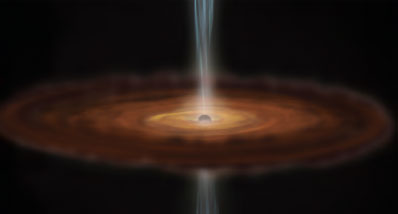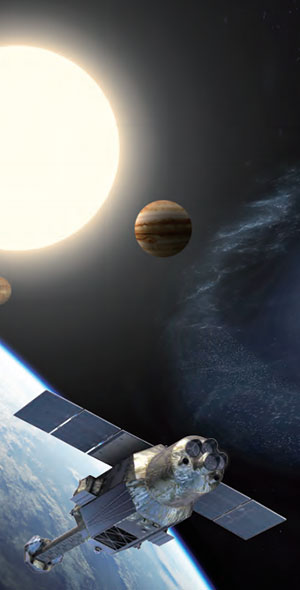Mysteries to be investigated by "Hitomi" (ASTRO-H)
1. Investigate the structure of the universe
How do black holes develop, and how do they impact their surroundings?
Black holes that range from a few hundred to 100 million times the mass of the sun reside at the center of almost all galaxies. However, how black holes were created and developed during the 13.8 billion year history of the universe has long been a mystery. Hitomi (ASTRO-H) will search for supermassive black holes as far away as 8 billion light years away, and by understanding their quantity and following their time variation in X-ray strength, it will be possible to investigate how supermassive black holes developed from the surrounding gas and whether it is possible for them to have grown by repeated collisions. Black holes not only accrete surrounding matter, they also eject matter outside of their galaxies. In particular, active supermassive black holes still in their early development are likely to strongly influence the evolution of galaxies and galaxy clusters, which is the equivalent of an orange-sized object having a significant effect on Earth. By making measurements such as the amount of gas accreted by black holes, the flow rate and speed of matter being ejected from black holes, it will be possible to make a closer and more direct estimate of the effect that supermassive black holes have on galaxies and galaxy clusters.

Illustration of a black hole
How are galaxy clusters created, and how do they evolve?
Galaxy clusters are the largest structures in the universe. All galaxy clusters appear to be a cluster of galaxies in the optical, but hot plasma observable in X-ray account for many times the mass, and dark matter which totals 5 times the mass of “observable” matter is also present. Utilizing the Doppler effect of X-rays, it will be possible to measure the dynamics of plasma with Hitomi (ASTRO-H). Physical parameters such as kinetic energy and dark matter mass can be calculated, and by comparisons with computer simulation, a clearer understanding of how galaxy clusters were created, interact, and evolve will become attainable.

Illustration of a galaxy cluster observed in optical light
When were heavy elements in the universe created, and how much?
Shortly after the beginning of the universe, there were only 3 elements: hydrogen, helium, and lithium. After that, close to 100 heavy elements were created from the inside of stars and supernovae, including carbon, oxygen, iron, and gold. Since then, the universe evolved into its current diverse state including planets and lifeforms. By observing supernova remnants which are the main birth places of heavy elements, and galaxy cluster plasma which have high concentrations of heavy elements, measurements of X-ray strengths of various heavy elements including rare metals such as chromium and manganese can be made which will allow a better understanding of where, when, and how much of these elements were created.
2. Investigation and discoveries of physics at extreme conditions

What physical phenomena are occurring in extreme conditions with high density and strong magnetic fields?
Sources called neutron stars and white dwarfs offer windows into extreme conditions of high density and strong magnetic fields that cannot be found on Earth. In such extreme conditions, peculiar phenomena are thought to occur such as superfluidity of protons due to high density, and the splitting of photons caused by strong magnetic fields. By observing the emitted X-rays and soft gamma rays originating from these extreme regions, the laws of physics controlling such phenomena can be more thoroughly defined and understood. Furthermore, the possibility of new laws that surpass the currently understood laws of physics may be investigated.
Is space time really distorted near black holes?
It has been more than 50 years since the beginning of X-ray astronomy. Evidence from various studies now strongly support that X-ray sources such as Cygnus X-1 are black holes accreting gas from companion stars, and that supermassive black holes 100 millions times as massive as the Sun exist at the center of galaxies. However, we have just reached a new era where it has become possible to directly observe the distortion of space time as predicted by Einstein’s theory of general relativity, and investigate whether the observed distortion can be used to investigate the rotation of black holes. Hitomi (ASTRO-H) will take on these challenging topics by observing the dynamics of the gas accreted by black holes.
Where and how are cosmic rays created?
It has been roughly 100 years since the discovery of cosmic rays, high energy particles that travel at 99.9999..% (10-20 trailing 9s) the speed of light. From observations with ASCA and Suzaku, it has become more evident that supernova remnants are the sources of cosmic rays. However, the structure of how these cosmic rays are accelerated is still unclear. Furthermore, the acceleration sites for the cosmic rays with the highest energies in particular have not yet been identified. By observing supernova remnants in broad range X-ray, Hitomi (ASTRO-H) will endeavor to reveal the acceleration mechanism of cosmic rays, and investigate the possibility of supermassive black holes and galaxy clusters are the sources of high energy cosmic rays.